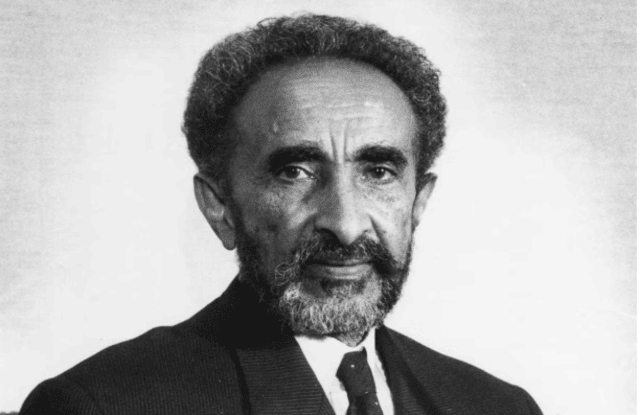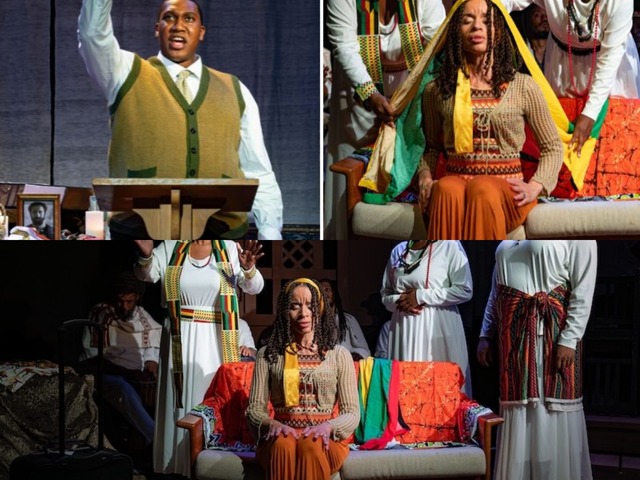The play Ethiopia dramatizes Italy’s 1935 invasion of Ethiopia, the country’s appeal to the League of Nations, and the enduring cultural and emotional ties between Africa and its diaspora. As theater critic Hannah Estifanos notes in DC Theater Arts, the show’s revival is both timely and resonant. (Photos by Bayou Elom)
Tadias Magazine
By Tadias Staff
Updated: May 21, 2025
TADIAS – Nearly 90 years after it was silenced, the play Ethiopia, one of the earliest works to emerge from the U.S. Federal Theatre Project, has finally been brought to life on the American stage. Originally set to premiere in 1936, the production was shut down before it ever reached the public — until now.
Washington, D.C.-based IN Series has resurrected this once-banned work as part of its 2025 season, Illicit Opera, which features plays suppressed at the time of their creation. The first act of the production is the long-lost Living Newspaper by Arthur Arent, dramatizing Italy’s 1935 invasion of Ethiopia and Emperor Haile Selassie’s impassioned appeal to the League of Nations. The second act is a contemporary response written by playwright Sybil R. Williams, connecting Ethiopia’s resistance to global movements, and paying homage to the enduring cultural and emotional ties between Africa and its diaspora.
The production’s visual world was crafted in part by Ethiopian American artist and designer Tsedaye Makonnen, whose work has long explored the intersections of identity, memory, and sanctuary. The minimalist set of the first act gives way to a vivid second act adorned with design elements evoking meskel cross patterns and traditional Ethiopian textiles — part of a layered symbolism that mirrors the diasporic journey at the heart of the show.
As theater critic Hannah Estifanos reports for DC Theater Arts, the show’s revival is not just historical — it’s personal and profoundly resonant.
A Censored Classic Finally Speaks
In the original 1936 script, Arent interwove speeches and newspaper headlines to create a striking collage of Ethiopia’s resistance and the world’s passive complicity. The play was set to end with a recording of President Franklin D. Roosevelt’s own words — but that request triggered a White House directive forbidding the impersonation of American leaders on stage. The production was immediately canceled following a single dress rehearsal.
Now, under the direction of IN Series Artistic Director Timothy Nelson, Arent’s text serves as the foundation for a dynamic two-act production. The cast — including Ezinne Elele, Elise Jenkins, Madison Norwood, Shana Oshiro, Daniel J. Smith, Nakia Verner, and Marvin Wayne — flows seamlessly between multiple roles, evoking the urgency of the 1930s with projected newspaper headlines and stark black-and-white visuals.
Daniel J. Smith’s portrayal of Emperor Haile Selassie is a particular standout, capturing both the solemnity and defiance of the leader’s famed 1936 speech: “It is far better to die on the field of battle, a free man, than to live as a slave!”
Sidebar: Ethiopia’s Historic Land Grant for the Diaspora

Haile Selassie was Emperor of Ethiopia from 1930 to 1974. (Getty Images)
Following the Italian invasion, Emperor Haile Selassie extended a rare and powerful invitation to Black Americans and Caribbeans: to settle in Ethiopia. He designated land grants as a gesture of solidarity, encouraging people of African descent to return and build a future. Though largely unfulfilled due to social and logistical challenges, the offer symbolized a Pan-African vision of unity — and resonates today as an early form of reparative diplomacy.
A Pan-African Response: Diaspora Awakens
The second act, crafted by Williams, expands the story from Ethiopia to the broader African diaspora. The stage explodes into color and texture as the narrative shifts to Mayme Richardson, an African American opera singer who visited Ethiopia during the invasion and later spread the word about Emperor Haile Selassie’s land grant.
Played by Nakia Verner, Richardson’s story becomes a bridge to a younger generation represented by Chloe, a fictional descendant portrayed by Shana Oshiro, who rediscovers her roots and adopts the Ethiopian name “Tsehay” (meaning sunshine). A chorus of women adorned in green, gold, and red headwraps and beads guides her journey, weaving multiple strands identity, memory, and resistance into one narrative.
Sacred Sounds and Layered Symbols
Music is a driving force in Ethiopia, with an original score composed by Janelle Gill that spans African American spirituals, nyabinghi drumming, and traditional Ethiopian instrumentation — including live masenqo performed by Woretaw Wubet. Gill’s on-stage presence, dressed in a traditional Ethiopian netela, underscored the sacred dimension of the work.
In the lobby, mixed media artist Mygenet Tesfaye Harris and ceramicist Ayda Biru contributed to the immersive experience with an art exhibit titled Wax & Gold, named after the Amharic poetic tradition of hidden meanings. As Estifanos notes, this idea of layered symbolism is central to the production itself — a blending of time periods, geographies, and perspectives that deepen the emotional and intellectual impact of the story.
Against the Odds
In another echo of its fraught origins, the production lost federal funding just two weeks before opening when the National Endowment for the Arts under the current administration pulled support. IN Series forged ahead thanks to emergency fundraising and private donors.
Though playwright Williams describes the production as a “first draft” with many threads still in progress, Ethiopia is already a landmark moment — not only in theatrical history, but in the cultural dialogue between Africa and its diaspora.
—
Next Performances:
Ethiopia will be performed at the Baltimore Theatre Project from May 30 to June 1, 2025.
45 W Preston St, Baltimore, MD
Tickets: $30 General | $20 Students — Purchase Online
With reporting by Hannah Estifanos for DC Theater Arts Photos by Bayou Elom
Join the conversation on X and Facebook.
Crédito: Link de origem


